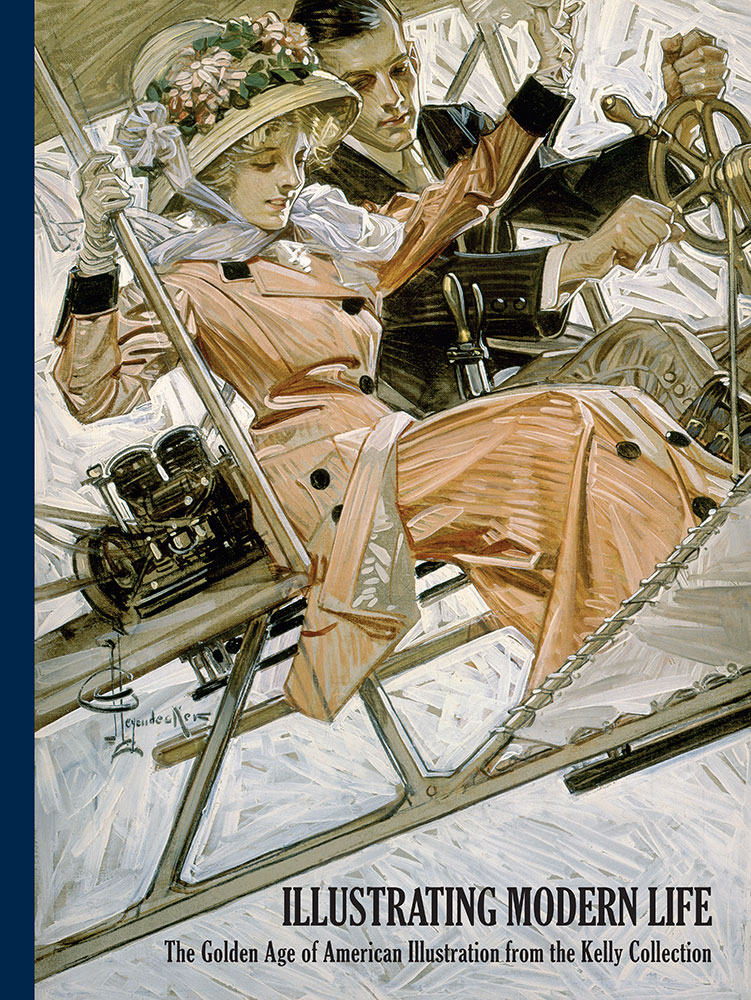Illustrating Modern Life: the Golden Age of American Illustration from the Kelly Collection
Authors: Michael Zakian – Richard Kelly – David Apatoff
Publisher: Frederick R. Weisman Museum of Art, Pepperdine University
ISBN-10: 1-882705-10-
ISBN-13: 978-1-882705-10-8
Illustrating Modern Life is the 112-page hardbound full color catalogue of the exhibit, “Illustrating Modern Life: the Golden Age of American Illustration from the Kelly Collection” at the Frederick R. Weisman Museum of Art located on the Pepperdine University campus in Malibu, California, from January 15 through March 31, 2013. Michael Zakian, the Museum’s art director, says that the exhibit is also a double commemoration: of Pepperdine University’s 75th anniversary, and of the Weisman Museum of Art’s 20th anniversary.
The exhibit presents 75 original paintings by 31 artists, including both well-known names like J. C. Leydendecker, Maxfield Parrish, and Norman Rockwell, and now-obscure popular painters like Harvey Dunn, Coles Phillips, and Sarah Stillwell Weber. Most of the paintings were intended as covers for the most popular magazines of this period such as Collier’s Weekly, Ladies’ Home Journal, Life, and The Saturday Evening Post, although some are fine-art paintings, novel dust jacket paintings or plates, full color advertising art such as J C. Leydendecker’s portrait of a well-dressed man wearing a Kuppenheimer Suit for The Saturday Evening Post issue of October 11, 1930, and a few black-&-white story interior illustrations. There are also several full paintings paired with an enlarged portion to better display its detail.
Zakian says in his Introduction, “American Illustration and the Adventure of Modern Life”, that the four decades from the 1890s through the 1930s, encompassing the Second Industrial Revolution through the Gilded Age, were the Golden Age of American Illustration. The rapid rise of popular magazines during this period of enthusiasm for the future, created a new audience for art—the American public—and a new demand for illustrations. This exhibit, chosen from the original art collection of Richard Kelly, showcases this thesis.
“The best of these artists captured the spirit of the era with infectious enthusiasm, as seen in J. C. Leydendecker’s ‘First Airplane Ride’. This painting, which appeared on the cover of the August 28, 1909, issue of Collier’s, portrays the visceral ecstasy of the bold new experience of flight. A young man and woman engage in the timeless activity of courting while flying in a startlingly new invention: an airplane. Although it was painted just six years after the Wright Brothers’ first successful manned flight, Leydendecker does not convey any fear or trepidation in his painting. Instead he emphasizes the pair’s appealing self-confidence, casting this quintessentially American couple as sophisticated and worldly bon vivants. […]” (p. 8)
Zakian notes that this period also saw the introduction of new artistic and printing techniques, and that the most popular artists adopted to these easily. Whether depicting the latest social styles (Harrison Fisher’s “Graduation, 1903”), modern labor (Edmund F. Ward’s “The Miracle: Men in the Quarry”, showing 1924 stonecutters), historical adventure (Howard Pyle’s “Dead Men Tell No Tales” and N. C. Wyeth’s “The Boy’s King Arthur), or romantic fantasy (Sarah Stilwell Weber’s “Lady With Leopards”), these pictures are dynamic and gaudy, standing out dramatically from the style of popular illustrations before the 1890s.
Zakian’s Introduction is followed by a long interview of Richard Kelly by “illustration scholar” David Apatoff on “Building a Collection”. Kelly started out as a science-fiction fan, and it was many of his favorite s-f artists like Michael Whelan, Tom Kidd, and James Gurney telling him that their inspirations were the popular artists of this “Golden Age of American Illustration” that got him collecting their art.
The Introduction and “Building a Collection” take up pages 7 to 25. The exhibition art fills pages 26 to 106. Brief biographies of the 31 artists plus Zakian, Kelly and Apatoff close the catalogue.
This $40.00 catalogue is bound in hard covers as a sturdy book. John Fleskes, the catalogue’s printer, says in a separate blog that, “All of the works hung in the museum are inside, plus a handful of extra pieces.” The exhibit will end on March 31, but the catalogue “is forever”; an excellent addition to any collection of American fine art or commercial art of the 1890-1940 period.












